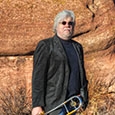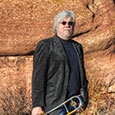.jpg)
A bit that I often use in my classes here at the Lamont School of Music at The University of Denver is that the world of the arts in the 21st century can best be described using the famous Dickensian line “The best of times and worst of times.” It is the best of times because technology has created an even playing field where artists are no longer under the thumb of corporate masters. It is the worst of times because technology has created an even playing field where artists are no longer under the thumb of corporate masters.
Yes, we as performers, composers, educators, and entertainers (more on that later) can get our music directly to the public without a record label or producer dictating our artistic direction. The little snag with that glorious fact is that the masses have decided that music should be free of charge. Amazingly, recorded music as a revenue stream is now virtually dead. Conversely, this frightening fact seems to be jump-starting a new era of entrepreneurship and diverse creativity that I believe can be described as a Renaissance in jazz itself that reflects the current state of the entire art community – a true example of a phoenix rising from the ashes.
As a person who began his career in the latter part of the 20th century, I of course bemoan the loss of the comfortable infrastructure of yore: that of the artist rep who would sign a promising performer or writer to a robust successful label and then develop and nurture every aspect of their career by actually selling product. Indeed, in those days, there was even a budget provided for this endeavor because the record companies could make money from it. This is not the case anymore; it is all gone and not coming back. So, what does this mean for jazz specifically and the arts in general?
I think this means we all need to become entrepreneurs, great marketing people, and genius business minds. In truth, I would rather just write music and play trombone, but there is tremendous potential in this brave new world by embracing the various technologies and learning to market yourself.
I see evidence of the benefit of ubiquitous technology first hand with the huge numbers of incredibly well-prepared young students that are pouring into our universities. Thanks to YouTube (the same entity that has so successfully destroyed our recorded music revenue stream), students of jazz can dial up a video of a J.J. Johnson concert and learn not only his vocabulary, but also his body language and how he approaches air efficiency and technique, as well. You can hear this in the best young players coming up these days – a startling early assimilation of the great bebop tradition via learned vocabulary. Many would point out that this does not represent true creativity, but instead is merely an efficient rote method of mimicry. I counter that thought with a quote from one of the masters:
“You need to work a long time before you can sound like yourself.”
–Miles Davis
I would also point to the time-honored mantra of the great Clark Terry: “Emulate, assimilate, innovate.” CT used this catchy phrase to describe the process of spontaneous composition in our music. Emulate the vocabulary, time, sound, and nuance of the great masters, assimilate it into your playing by hitting the shed, and you will eventually equip and free yourself to innovate with your distinct voice. Using these wise words from the great man as a measuring device as well as a call to action, I believe that our young artists are well on their way towards innovation – but how?
Here at Lamont, I am regularly told about new musical groups from our talented students. In almost every case, I’ve never heard of these ensembles.
Me: “What a fresh groove! Where did you get that from?”
Student: “From the Crooked Fence Rooster Critters.”
Me: “The who?”
Student: “The Critters man! They are heavily influenced by Invalid Porpoise, surely you are hip to the Porpoise?”
Me: “Uh . . . nope.”
Student: “Wow.”
At this point – my street cred temporarily diminished – I go to YouTube and find twenty unbelievably hip and professionally rendered videos by whatever flavor-of-the-week group the student has suggested, each with more than 300,000 views. This is 21st century marketing and entrepreneurship in action. Plus, perhaps most importantly, these groups often combine aspects of multiple genres across the entire spectrum of music. Best of all (for me anyway), I learn something new from each viewing and steal it for my stuff.
That brings us to one of the most exciting aspects of what I see going on right now in our art community. All styles of music are on the table. The better and more diverse the education a young artist has, the more they are using that wide-ranging palette in their music. Just ask any young monster performers who they are into, and you will hear about some new group or artist that will improve your day.
Of course, there are the downsides to today’s fast and infinite delivery of free music. Few students get the luxury of reading liner notes and getting to know the complete personnel in each band like we denizens of the 20th century got to do, but this is where a college education comes into play. What a joy to turn some burning young freshman on to Dizzy Gillespie’s Sonny Side Up or Dexter Gordon’s A Day in Copenhagen.
As for the obvious downside of the fiscal death of recorded music, incredibly, there are upsides to that as well. The most exciting development that I have seen is that the demand for live music seems to be on the rise. With myriad other technologies in the business realm, young talents are booking their own tours and getting out on the road. CDs and even LPs are still being made, but these days they are only sold at performances for the most part. As for these live events. I hear everything from small groups that are deep into emulating Miles Davis’s Live at the Plugged Nickel to hybrid ensembles of all kinds of variations – with and without vocalists – lyrics or no lyrics, all playing interesting, catchy and creative music that defies category.
Now we return to being an entertainer. I believe that involving your audience in your performance could be the most important thing to teach and emphasize as we prepare students for a career in this new age. If you are going to be a successful entrepreneur, you need to have an engaging product. You can present some of the most technically proficient and arcane genius-level stuff to a crowd and bore them (and yourself) to tears. You can also give an audience a heartfelt killer groove that is simple but sticky and bring down the house. Why not do both? That is what I hear from many of today’s successful artists – a thorough understanding of the vocabulary and tradition of jazz along with entertaining, fun, and hip elements of many, many other styles of music all rolled up into one enjoyable package. For me, Troy Andrews (AKA Trombone Shorty) exemplifies this new wide-open spirit that comes from firm roots in the tradition while assimilating favorite aspects of other styles.
I am adopting this approach into my writing and playing. While continuing to assimilate the vocabulary and rhythmic-harmonic persona of my favorite masters in jazz as a trombonist, I have created a dream all-star ensemble that – while being informed by multiple elements of jazz – can best be described as a modern rock-pop-funk horn band. Called Vinyl Hampdin, this band gives me a chance to channel my inner Jimmy Pankow from the rock group Chicago while incorporating exciting new elements of modern pop and rock and mixing the whole thing together with killer jazz-derived horn lines. Lisa Dodd, a stellar vocalist from Canada tops off this all-star assemblage of Grammy and Juno-winning musicians. I am having a blast with it.
At the end of the day, jazz artists and educators have nothing to fear from the 21st century. Indeed, if we allow ourselves to be, we are all part of an exciting new era that combines the tradition, heart and soul of our music with wonderfully diverse elements from all across the globe. I think that the secret is to be honest to your own heart, work incredibly hard, and play well with others while also being hip to what I once heard the master of masters Dizzy Gillespie say: “The more I learn, the more I learn there is to learn!” Another way that I describe all of this at Lamont is to survive and thrive, defined thusly:
Survive: become a great business and marketing person and devise methods to make enough money to support your chosen lifestyle responsibly.
Thrive: always remember to take care of your artistic-creative heart.
That said, I amend my earlier Dickens quote to say we now find ourselves in the best of times!






